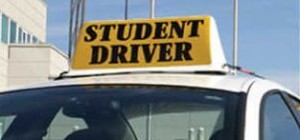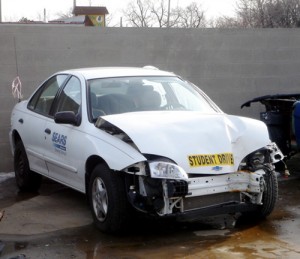Today while running errands I found myself driving behind an erratic driver in a compact car. She was crawling at what seemed like walking speed on a country road with a speed limit of 55.
It was easy to be patient, however, because on the roof of her car was a big yellow sign that said, “STUDENT DRIVER.” As a matter of fact, I was happy to put some distance between us, giving her space to make mistakes without pulling me into the mix. While waiting several car lengths back for her left turn, I breathed a quick prayer of gratitude that I was finished sitting shotgun for 7 driving wanna-be’s in my own family.
Handing the keys to an inexperienced 15-year-old when the minivan he was practicing on was mine, always went against me. One maiden voyage home from the DMV with a new learner’s permit at the controls saw us taking turns on 2 wheels. Thank goodness that’s over.
The saintly patience of driving teachers has always been impressive. A career of climbing in next to one green driver after another, day after day, year after year, has to be the ultimate test of endurance. It must be a difficult life to have to continually be braced for impact.
Of course these dedicated instructors do have one advantage over the rest of us: dual controls. Though they sit on the right like any other passenger, the second set of gas and brake pedals are tools they can use to avert an accident and prevent damage to vehicles, drivers, and themselves.
The idea behind a driving education course is to let a novice accumulate on-the-road experience in a semi-safe vehicle. The job of the trainer, then, is to let them retain control until the last second before disaster strikes, refraining from using the emergency pedals until the student has no time left for a correction.
I like to think of God watching over us in a similar way. There’s just one big difference: he doesn’t always use that second set of pedals when he could. Though he’s able to prevent our every mistake and accident, he usually doesn’t. That’s because we learn best from our blunders.
What if an exasperated student driver asks her instructor to get out of the car? If he does, she leaves herself without a safety net. Both she and the car are at risk, because the experienced feet that had been hovering over the second set of pedals have disappeared. With the Lord, it’s something similar. If we ask him to stay out of our lives, he probably will. He’ll continue to be concerned for us, to love us, and to hope we’ll re-invite him in.
The question is, how much accidental damage will that take?
“It’s best to stay in touch with both sides of an issue. A person who fears God deals responsibly with all of reality, not just a piece of it.” (Ecclesiastes 7:18, The Message)



My kids used to tell me that I really didn’t have a brake on the passenger side – but there really is one there. I ought to know – I used it plenty of times!